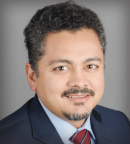“Continuous improvement is better than delayed perfection.”
—Mark Twain
To complement The ASCO Post’s extensive coverage of the 2021 ASCO Annual Meeting, here are several abstracts selected from the meeting proceedings focusing on novel treatments under study in high-risk multiple myeloma. For full details of the study abstracts, visit meetinglibrary.asco.org.

Syed Ali Abutalib, MD

Saad Z. Usmani, MD, MBA, FACP
Daratumumab-Based Therapy
ABSTRACT 8001: Depth of response and measurable residual disease (MRD) status in ultrahigh-risk multiple myeloma and plasma cell leukemia treated with four drugs—daratumumab, bortezomib, lenalidomide, cyclophosphamide, and dexamethasone (daratumumab-VRCd; up to 6 cycles) with bortezomib-augmented single high-dose melphalan and autologous hematopoietic cell transplantation (auto-HCT) followed by either daratumumab plus VRd consolidation-1 (6 cycles) or daratumumab plus VR (without dexamethasone) consolidation 2 (12 cycles) and daratumumab plus lenalidomide maintenance (until progressive disease): Results of the UK optimum/MUK9b trial (ClinicalTrials.gov identifier NCT03188172)1,2
Rationale: Such patients with poor-risk myeloma are characterized by high-risk genetic and distinct gene-expression profiles. There have been no significant improvements in outcome over the past decade for these patients. The MUK9 trial is designed to evaluate treatment strategies for such a group of patients and incorporate a genetic screening component (primary endpoint).
Methods: Patients with suspected or newly diagnosed multiple myeloma, fit for intensive therapy, are offered participation in a tumor genetic screening protocol (MUK9a), with molecular screening performed within 8 weeks. High-risk disease was defined by double-hit with the presence of at least two consensus high-risk markers—t(4;14), t(14;16), t(14;20), del(1p), gain(1q), del(17p)—and a diagnostic gene-expression profile SKY92 (SkylineDx) high-risk signature. If clinically indicated, therapy with VTD (bortezomib, thalidomide, dexamethasone; maximum of two cycles) can be given while central results are awaited. The MUK9b’s primary endpoints are MRD at day +100 following augmented auto-HCT and progression-free survival. Patients identified as not having high-risk disease per protocol receive standard treatment and are followed in a cohort study.
Key Findings: The median follow-up for the 107 patients in the safety population was 22.2 months. Bone marrow aspirates suitable for MRD assessment by flow cytometry (10-5 sensitivity) were available for 78% at day +100 after augmented auto-HCT. In the intention-to-treat population at day +100 after augmented auto-HCT, the overall response rate was 83%, with 47% complete responses, 32% very good partial responses, 5% partial responses, and 7% progressive disease (with 10% time point not reached). A total of 64% achieved MRD negativity, 14% had MRD positivity, and 22% were not evaluable at day +100 after augmented auto-HCT. Responses at day +100 after augmented auto-HCT were lower in those with plasma cell leukemia, with complete responses in 22%, very good partial responses in 22%, and progressive disease in 22% (with 12% time point not reached).
Clinical Implications: The SWOG-1211 trial3 was the first enrichment-design randomized phase II trial for high-risk newly diagnosed MM (including plasma cell leukemia) that has not shown a benefit in adding elotuzumab to VRd for induction and maintenance. However, it makes a strong case for proteasome inhibitor or immunomodulatory maintenance for high-risk patients with multiple myeloma. This is the first report of the UK optimum/MUK9b trial focused on ultrahigh-risk newly diagnosed multiple myeloma and plasma cell leukemia to investigate the addition of daratumumab to VRCd induction and post auto-HCT consolidation with daratumumab plus VRd or daratumumab plus VR in yet another “modern total therapy” schema. Response rates were high in this difficult-to-treat patient population, with toxicity comparable to that of other induction regimens. However, early disease progression is still observed, highlighting the need for novel targets and strategies.
Carfilzomib-Based Therapy
ABSTRACT 8002: Carfilzomib-based induction and consolidation with or without auto-HCT followed by carfilzomib/lenalidomide (KR) vs lenalidomide maintenance: A subgroup analysis of protocol-defined high-risk patients (NCT02203643).4
Rationale: In the FORTE study, 4 cycles of carfilzomib/lenalidomide/dexamethasone (KRd) induction followed by auto-HCT and 4 cycles of KRd consolidation significantly improved progression-free survival vs 12 cycles of KRd without auto-HCT (hazard ratio = 0.64) or 4 cycles of carfilzomib/cyclophosphamide/dexamethasone (KCd) induction plus auto-HCT and 4 cycles of KCd consolidation (HR = 0.53). KR maintenance significantly improved progression-free survival vs lenalidomide alone (HR = 0.63).
Methods: In the FORTE study, patients were randomly assigned to KRd induction followed by auto-HCT and KRd consolidation vs KCd induction followed by auto-HCT and KCd consolidation vs 12 cycles of KRd and, thereafter, KR vs lenalidomide maintenance. Subgroup analyses according to fluorescent in situ hybridization evaluated the impact of each single high-risk abnormality defined here as having del(17p), t(4;14), t(14;16), del(1p), and 1q gain (3 copies) or amp1q (≥ 4 copies) and that of combined cytogenetic abnormality. High risk was defined by the presence of one high-risk cytogenetic abnormality (n = 243) and double-hit by the presence of at least two high-risk cytogenetic abnormalities (n = 105). Patients who had no protocol-defined high-risk cytogenetic abnormalities were considered to be at standard risk (n = 153). The primary objective of analysis was the impact of treatment on progression-free survival.
Key Findings: In high-risk patients, KRd induction followed by auto-HCT and KRd consolidation improved progression-free survival vs 12 cycles of KRd (HR = 0.6, P = .04) and KCd induction followed by auto-HCT and KCd consolidation (HR = 0.57, P = .01), with a 4-year progression-free survival of 62%, 45%, and 45%, respectively. The advantage with KRd induction followed by auto-HCT and KRd consolidation vs 12 cycles of KRd (HR = 0.53, P = .07) and KCd induction followed by auto-HCT and KCd consolidation (HR = 0.49; P = .03) was also observed in double-hit patients (4-year progression-free survival of 55%, 31%, and 33%, respectively). Analyses by single cytogenetic abnormality were limited by the small number of patients in each subgroup, but patients with amp1q had the worst outcome regardless of FORTE treatment strategy.
Clinical Implications: The FORTE trial continues to impress and augments the role for proteasome inhibitor or immunomodulatory induction in transplant-eligible patients, as well as proteasome inhibitor or immunomodulatory maintenance strategy for high-risk multiple myeloma. KRd induction followed by auto-HCT and KRd consolidation and KR maintenance are effective in standard-risk, high-risk, and double-hit patients, with impressive 4-year progression-free survival from diagnosis (KRd induction followed by auto-HCT: high-risk, 62%; double-hit, 55%) and 3-year progression-free survival from maintenance (KR: high-risk, 69%; double-hit, 67%), thus supporting their use in high-risk patients. The outcomes of amplification of chromosome 1q21 (defined by at least 4 copies) remains relatively poor compared with gain of 1q21 (3 copies) or normal 1q21 status (2 copies).
KRd induction followed by auto-HCT and KRd consolidation and KR maintenance are effective in standard-risk, high-risk, and double-hit patients…— Syed Ali Abutalib, MD, and Saad Z. Usmani, MD, MBA, FACP
Tweet this quote
BCMA-Directed CAR T-Cell Therapy
ABSTRACT 8005: Phase Ib/II single arm study evaluating ciltacabtagene autoleucel (JNJ-68284528), a B-cell maturation antigen (BCMA)-directed chimeric antigen receptor (CAR) T-cell therapy, in relapsed or refractory multiple myeloma: Updated results from CARTITUDE-1 (NCT03548207).5,6
Rationale: CARTITUDE-1 aimed to assess the safety and clinical activity of ciltacabtagene autoleucel, a CAR T-cell therapy with two BCMA-targeting single-domain antibodies.
Methods: Eligible patients had received at least three prior regimens or were double refractory to a proteasome inhibitor and immunomodulatory drug and had received a proteasome inhibitor, immunomodulatory drug, and anti-CD38 antibody. After apheresis, bridging therapy was permitted. Patients received a single ciltacabtagene autoleucel infusion (target dose: 0.75 × 106 CAR-positive viable T cells/kg; range 0.5–1.0 × 106) 5 to 7 days after lymphodepletion (300 mg/m2 of cyclophosphamide, 30 mg/m2 of fludarabine daily for 3 days). The primary objectives were to characterize the agent’s safety, confirm the recommended phase II dose (phase Ib), and evaluate efficacy (phase II).
Key Findings: As of September 1, 2020, 97 of 113 patients, with a median of six prior lines of therapy, received ciltacabtagene autoleucel.
Responses: The overall response rate per independent review committee (primary endpoint) was 97% (95% confidence interval [CI] = 91%–99%), with 67% achieving a stringent complete response. The median time to first response was 1 month (range, 1–9 months), and the median time to at least a complete response was 2 months (range, 1–15 months). Responses deepened over time, and the median duration of response was not reached. Of 57 patients evaluable for MRD assessment, 93% achieved MRD negativity at 10-5. The 12-month progression-free survival and overall survival rates (95% CI) were 77% (66%–84%) and 89% (80%–94%), respectively; median progression-free survival was not reached.
Toxicity: Grade 3 or 4 hematologic adverse events ≥ 20% included neutropenia (95%), anemia (68%), leukopenia (61%), thrombocytopenia (60%), and lymphopenia (50%). Cytokine-release syndrome occurred in 95% of patients (4%, grade 3 or 4), with a median time to onset of 7 days (range, 1–12 days) and a median duration of 4 days (range, 1–14 days, excluding 1 patient with a duration of 97 days). Cytokine-release syndrome resolved in all but one patient (who had grade 5 cytokine-release syndrome/hemophagocytic lymphohistiocytosis). CAR T-cell neurotoxicity occurred in 21% of patients (grade ≥ 3, 10%). A total of 14 deaths occurred during the study after ciltacabtagene autoleucel infusion, none within the first 30 days, 2 within 100 days, and 12 more than 100 days post infusion. Of these deaths, six were the result of treatment-related adverse events; five, progressive disease; and three, treatment-unrelated adverse events.
Clinical Implications: A single infusion of ciltacabtagene autoleucel yielded early, deep, and durable responses in heavily pretreated patients, with a manageable safety profile at the recommended phase II dose. Ciltacabtagene autoleucel is under further investigation in earlier lines of therapy. The data from this study formed the basis for recent regulatory submissions.
DISCLOSURE: Dr. Abutalib has served on the advisory board for AstraZeneca. Dr. Usmani has received research funding from Amgen, Array Biopharma, BMS, Celgene, GSK, Janssen, Merck, Pharmacyclics, Sanofi, Seattle Genetics, SkylineDX, and Takeda; consulting fees from Amgen, BMS, Celgene, EdoPharma, Gilead, Genentech, GSK, Janssen, Oncopeptides, Sanofi, Seattle Genetics, SecuraBio, SkylineDX, Takeda, and TeneoBio; and speaker fees from Amgen, BMS, Janssen, and Sanofi.
Dr. Abutalib is Director, Hematology and BMT/Cellular Therapy Programs; Director, Clinical Apheresis Programs; Cancer Treatment Centers of America, Zion, Illinois; Associate Professor, Rosalind Franklin University of Medicine and Science; and Founder and Co-Editor of Advances in Cell and Gene Therapy. Dr. Usmani is Incoming Chief of the Myeloma Service, Memorial Sloan Kettering Cancer Center, New York, New York.
REFERENCES
1. Kaiser MF, Hall A, Walker K, et al: Depth of response and minimal residual disease status in ultrahigh-risk multiple myeloma and plasma cell leukemia treated with daratumumab, bortezomib, lenalidomide, cyclophosphamide and dexamethasone (Dara-CVRd): Results of the UK optimum/MUKnine trial. 2021 ASCO Annual Meeting. Abstract 8001. Presented June 4, 2021.
2. Pawlyn C: High-risk myeloma: A challenge to define and to determine the optimal treatment. Lancet Haematol 8:e4-e6, 2021.
3. Usmani SZ, Hoering A, Ailawadhi S, et al; SWOG1211 Trial Investigators: Bortezomib, lenalidomide, and dexamethasone with or without elotuzumab in patients with untreated, high-risk multiple myeloma (SWOG-1211): Primary analysis of a randomised, phase 2 trial. Lancet Haematol 8:e45-e54, 2021.
4. Gay F, Mina R, Rota-Scalabrini D, et al: Carfilzomib-based induction/consolidation with or without autologous transplant followed by lenalidomide or carfilzomib-lenalidomide maintenance: Efficacy in high-risk patients. 2021 ASCO Annual Meeting. Abstract 8002. Presented June 4, 2021.
5. Usmani SZ, Berdeja JG, Madduri D, et al: Ciltacabtagene autoleucel, a B-cell maturation antigen (BCMA)-directed chimeric antigen receptor T-cell (CAR-T) therapy, in relapsed/refractory multiple myeloma: Updated results from CARTITUDE-1. 2021 ASCO Annual Meeting. Abstract 8005. Presented June 4, 2021.
6. Berdeja JG, Madduri D, Usmani SZ, et al: Ciltacabtagene autoleucel, a B-cell maturation antigen-directed chimeric antigen receptor T-cell therapy in patients with relapsed or refractory multiple myeloma (CARTITUDE-1): A phase 1b/2 open-label study. Lancet 398:314-324, 2021.

